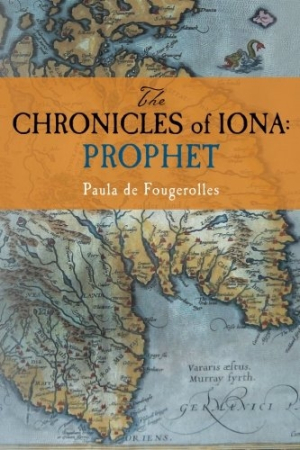The Chronicles of Iona
Prophet
As wonderful and elegant a saga as Chronicles of Iona: Exile was, Paula de Fougerolle’s sequel is even better. The first volume in the series took its twin protagonists from boyhood to early manhood; the second brings them to their full adulthood standing as holy man and warlord. While the term “epic” is often too casually bandied about, there is no doubt that this series is deserving of that epithet.
While Chronicles of Iona: Prophet is enjoyed best after the previous volume is devoured, this second installment is hearty enough to stand on its own. It is a thoroughly researched and historically sound novelization of the story of the two founding pillars of the Scottish nation: St. Columba and Aedan mac Gabran. With elegant and lyrical writing, de Fougerolles has composed a thrilling and fast-paced journey that cuts through the mists of legend without losing the magic and wonder of myth.
Set thirty years after the death of King Arthur, de Fougerolles’s book is nonetheless Arthurian in scope and feel. The author, a noted linguist and scholar of the era, has packed in everything fans of the genre could want. There are raids and rapes, seductions and sodomies, battles and ball games, drownings and decapitations, rituals and races, storms and stolen kisses, and even some religious debates. The Loch Ness Monster (whom St. Columba is said to have bested) is thrown in for good measure. All of these make for grand fun, but the story is hardly lighthearted, for as Columba warns a young novice monk, “There are horrors here of which you have never heard.”
The narrative is an adventure with heroes great and small, villains evil and mean (both in character and in stature), princesses wild and demure, and many other characters fair and foul. Except for recounting events of the first book, very little is told here—in fact, most of the action is shown in great, bloody splendor. As such, it will appeal to fans of Bernard Cornwell’s The Saxon Tales, readers of George R. R. Martin’s A Game of Thrones, and any who enjoy stories of King Arthur or the Dark Ages.
Readers unfamiliar with the crazy and confusing patchwork of clans and kinglets sprinkled about Ireland, Scotland, and the remnants of Roman Briton may have some initial difficulty figuring out who is who, let alone on which team they are playing in this royal game. The author does her mightiest, however, to make that as clear as possible. There are extensive notes and guides in the back of the text, although most readers will, unfortunately, not notice these aids until they finish the novel. Additional notice up front (beyond the listing in the table of contents) that these resources exist would have been helpful, and some of the explanatory material could have been relegated to footnotes.
These small complaints aside, de Fougerolles’s book is a thoroughly engrossing tale that provides entertainment and insight into the legends and history of the Irish, Scottish, and British people.
Reviewed by
Mark McLaughlin
Disclosure: This article is not an endorsement, but a review. The publisher of this book provided free copies of the book and paid a small fee to have their book reviewed by a professional reviewer. Foreword Reviews and Clarion Reviews make no guarantee that the publisher will receive a positive review. Foreword Magazine, Inc. is disclosing this in accordance with the Federal Trade Commission’s 16 CFR, Part 255.

